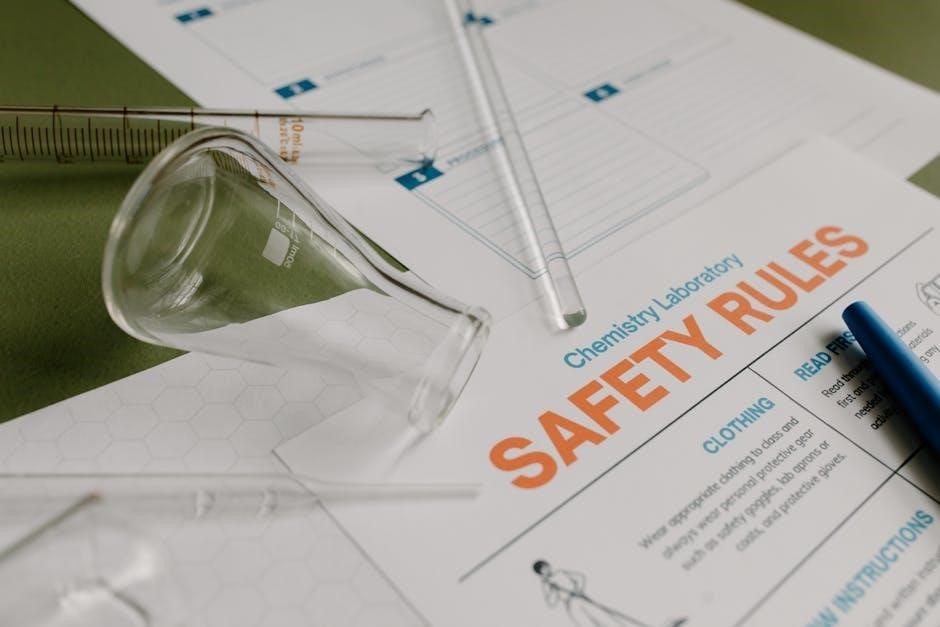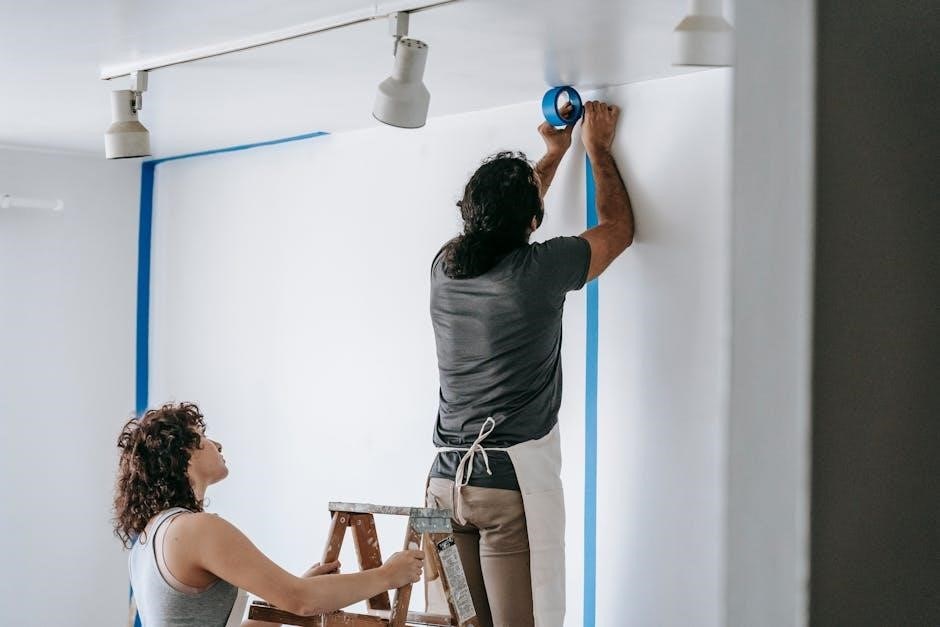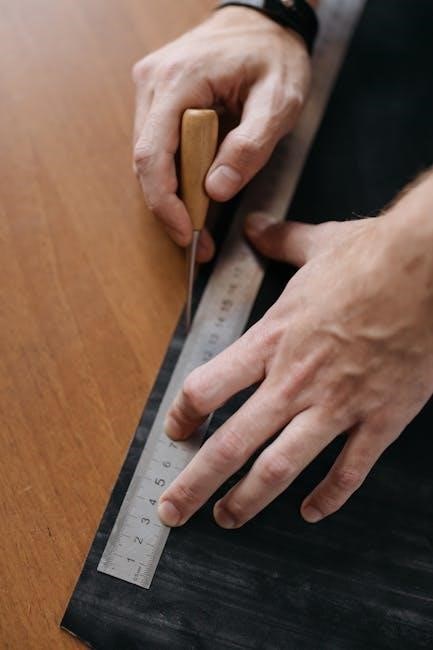Accurate measurements are essential for a perfect fit in clothing. This guide helps men measure key body dimensions for shirts, pants, suits, and underwear, ensuring comfort and confidence.
Overview of the Importance of Accurate Measurements
Accurate measurements are crucial for ensuring a perfect fit in clothing, reducing the likelihood of returns and exchanges. Proper sizing enhances comfort, confidence, and the overall appearance of garments. By understanding key measurements, men can make informed purchasing decisions, whether shopping online or in-store. Additionally, precise measurements are vital for tailoring and custom-made clothing, ensuring a seamless fit. They also help in maintaining consistency across different brands and styles, making it easier to navigate size charts. Avoiding ill-fitting clothes boosts personal style and self-assurance, making accurate measurements an essential step in building a well-fitted wardrobe.
Common Mistakes to Avoid When Taking Measurements
When taking measurements, common errors include using a rigid tape measure, which can lead to inaccurate results. Failing to maintain proper posture, such as slouching or leaning, can also skew measurements. Another mistake is measuring over bulky clothing, as this adds extra inches. Additionally, not aligning the tape measure correctly with key landmarks, like the natural waistline or base of the neck, can result in poor fit. Measuring too tightly or loosely is another pitfall, as it can cause discomfort or sagging. To ensure accuracy, take multiple measurements and double-check them. Avoid guessing sizes; instead, rely on precise data for the best fit.

Understanding Men’s Measurements
Understanding men’s measurements is fundamental for ensuring a perfect fit in clothing. It involves knowing key dimensions like chest, waist, inseam, and sleeve length. Accurate measurements ensure comfort, style, and confidence.
Key Body Measurements for Clothing Fit
Key body measurements for clothing fit include chest, waist, hips, inseam, and sleeve length. These measurements ensure garments fit properly, providing comfort and style. Chest measurement is taken around the fullest part, while waist is measured at the natural narrowest point. Hips are measured 7-9 inches below the waist. Inseam is from the crotch to ankle, and sleeve length from shoulder to wrist. Accurate measurements help determine size in shirts, pants, suits, and underwear, ensuring a tailored fit. Consistency in measuring is crucial for reliability and optimal clothing selection.
How to Use a Tape Measure Correctly
Using a tape measure correctly ensures accurate body measurements. Start by holding the tape snug but not tight, keeping it level and parallel to the floor. For chest measurements, wrap the tape around the fullest part, keeping arms at sides. For waist, measure at the natural narrowest point, usually just above the belly button. Hips are measured 7-9 inches below the waistline. When measuring sleeves, bend the arm slightly and place the tape from the center back of the neck to the wrist. Ensure the tape is not twisted or angled, as this can lead to inaccurate results. Consistency and proper alignment are key for reliable measurements.
Understanding Size Charts and How They Relate to Measurements
Size charts are essential tools that translate body measurements into clothing sizes. They vary by brand and region, so reviewing a brand’s specific chart is crucial. Typically, charts include measurements like chest, waist, inseam, and sleeve length. To use them effectively, take accurate body measurements and compare them to the chart. Keep in mind that fit types (slim, regular, loose) influence sizing. Always check the chart before purchasing to ensure the best fit. By understanding how your measurements align with the chart, you can make informed decisions and reduce the likelihood of sizing errors. Consistent use of size charts ensures a better shopping experience.

How to Take Body Measurements
Use a flexible tape measure to record accurate body dimensions. Stand straight, keep the tape level, and measure without slack for consistent results. Assistance may help for hard-to-reach areas.
Tools Needed for Accurate Measurements
A flexible tape measure is the primary tool for taking body measurements. Ensure it is made of durable material and has clear markings in inches or centimeters. Stand straight and maintain a relaxed posture while measuring. Use a mirror to ensure the tape is level, especially for hard-to-reach areas like the back. For precise measurements, avoid clothing that could distort the readings. Keep a notebook or digital tool handy to record your measurements accurately. Consistency is key, so always measure under the same conditions and consider enlisting assistance for precise results. Accurate measurements ensure the best fit for clothing, reducing the need for alterations or returns.
Step-by-Step Guide to Measuring Your Body
Prepare: Stand straight, remove bulky clothing, and ensure the tape measure is flexible and has clear markings.
Chest: Wrap the tape around the fullest part of your chest, keeping it level and parallel to the floor.
Waist: Measure the narrowest point of your natural waistline, keeping the tape loose but not sagging.
Inseam: Measure from the base of your groin to the top of your ankle bone on the inside of your leg.
Sleeve Length: Measure from the center back of your neck, over your shoulder, and down to your wrist with your arm slightly bent.
Neck: Measure around the base of your neck, keeping the tape snug but comfortable.
Hips/Thighs: For pants, measure around the widest part of your hips and thighs, ensuring the tape is level.
By following these steps, you can ensure accurate and consistent measurements for the best clothing fit.
Tips for Taking Measurements Alone vs. with Assistance
When measuring alone, use a flexible tape measure and ensure it’s level. For accuracy, take multiple measurements and average them. Use a mirror to check positioning, especially for hard-to-reach areas like the back. Record measurements immediately to avoid forgetting. If assisted, ensure the helper stands at your height and maintains a consistent tension on the tape. Communicate clearly about comfort and fit. For best results, measure at the same time of day and under similar conditions. Consistency is key for reliable data. Whether alone or with help, patience and attention to detail ensure precise results for the perfect fit.
How to Ensure Consistency in Measurements
To ensure consistency, always measure at the same time of day, as body measurements can vary slightly. Wear the same type of clothing each time to avoid discrepancies. Use a high-quality, flexible tape measure and maintain the same tension. Record measurements immediately to prevent forgetting. For repeat measurements, compare them over time to track changes. Always stand up straight and relax your muscles to avoid distortion. Measure in front of a mirror to verify proper placement. Establish a routine and use the same reference points each time. Consistency is key to accurate and reliable results for the best fit.

Men’s Shirt Measurements Guide
Mastering shirt measurements ensures a perfect fit. Key measurements include chest, sleeve length, and neck circumference. Use a flexible tape measure for accuracy and compare with size charts to avoid returns.
How to Measure Shirt Size Accurately
To measure your shirt size accurately, start by wrapping a flexible tape measure around the fullest part of your chest, keeping the tape level and parallel to the floor. Ensure the tape isn’t too tight or too loose. Note the measurement in inches or centimeters. Next, measure the length of your sleeve by placing the tape at the center back of your neck, running it over your shoulder, and down to your wrist. For the neck, measure around the base where the collar sits. Compare these measurements to a size chart for the best fit. Consistency is key to avoiding sizing errors and ensuring comfort.
Understanding Chest, Waist, and Sleeve Measurements
Chest measurement is taken around the fullest part of your torso, ensuring the tape is level and not too tight. Waist measurement is taken at the natural waistline, usually just above the hipbone, and is used to determine shirt length and fit. Sleeve measurement is taken from the center back of your neck, over your shoulder, and down to your wrist. These measurements are crucial for ensuring shirts fit comfortably and proportionally. By understanding these key dimensions, you can accurately interpret size charts and select clothing that aligns with your body proportions for a tailored look.
How to Determine Your Collar Size
To determine your collar size, wrap a flexible tape measure around the base of your neck, just above your Adam’s apple. Ensure the tape is level and not too tight or loose. The measurement should allow room for two fingers to fit comfortably. This ensures a comfortable fit without being restrictive. For accuracy, stand up straight and relax your shoulders while measuring. Your collar size is a critical factor in achieving a well-fitted shirt, as it directly impacts the comfort and appearance of the garment. By following this simple process, you can ensure your shirts sit perfectly around your neck, enhancing both style and comfort.

Men’s Pant Measurements Guide
To determine your collar size, measure around the base of your neck, just above the Adam’s apple, using a flexible tape measure. Ensure the tape is level and not too tight or loose. The measurement should allow room for two fingers to fit comfortably. This ensures a comfortable fit without being restrictive. For accuracy, stand up straight and relax your shoulders while measuring. Your collar size is a critical factor in achieving a well-fitted shirt, as it directly impacts the comfort and appearance of the garment. By following this simple process, you can ensure your shirts sit perfectly around your neck, enhancing both style and comfort.
How to Measure Waist Size for Pants
To measure your waist size for pants, locate your natural waistline, typically just above the hip bone. Use a flexible tape measure and stand up straight. Wrap the tape around your torso, ensuring it’s parallel to the floor and not too tight or loose. The measurement should allow for about two fingers to fit comfortably underneath the tape. This ensures a comfortable fit without restricting movement. Note that your waist size for pants may differ from your shirt waist measurement, as pants typically sit lower. For accuracy, measure over lightweight clothing or underwear. Record the number to ensure the best fit for your pants.
- Stand upright and relax your stomach for an accurate reading.
- Ensure the tape measure is not twisted or angled.
- Take the measurement without holding your breath or tensing up.
Understanding Inseam and Outseam Measurements
Inseam and outseam measurements are crucial for determining pant length. The inseam is the distance from the crotch seam to the bottom of the pant leg, while the outseam measures from the waistline to the hem. These measurements ensure proper fit and comfort. To measure inseam, stand straight and use a tape measure from the base of the crotch to the desired pant length. For outseam, measure from the top of the waistband to the bottom of the hem. Accurate measurements help avoid pants that are too short or too long, ensuring a tailored look and optimal comfort.
- Inseam affects how pants sit on the leg and shoe.
- Outseam impacts the overall style and balance of the outfit.
How to Measure Hip and Thigh for Perfect Fit
Measuring the hips and thighs ensures pants fit comfortably and look tailored. To measure the hips, stand straight and wrap the tape measure around the widest part, about 7-9 inches below the waistline. For the thigh, measure the circumference at the midpoint, about 1-2 inches below the crotch. Keep the tape snug but not tight. These measurements help determine the best fit for pants, especially for styles like slim-fit or loose-fit. Accurate hip and thigh measurements ensure comfort and prevent issues like tight fabric or excessive fabric bunching.
- Measure hips at the widest point for an accurate fit.
- Thigh measurement ensures proper fit around the legs.

Men’s Suit Measurements Guide
A suit’s perfect fit relies on precise jacket, pant, and overall body measurements. Accurate sizing ensures a tailored look, essential for formal and business attire.
How to Measure for a Suit Jacket
Measuring for a suit jacket involves several key steps to ensure the best fit. Start by wrapping a flexible tape measure around the broadest part of your chest, keeping the tape level and parallel to the floor. This gives your chest measurement. Next, measure your shoulder length by placing the tape from the base of one shoulder, over the shoulder, and to the base of the other. Then, measure your jacket length by placing the tape from the top of your shoulder, down to your hip, ensuring the tape is straight. Additionally, measure your sleeve length by placing the tape from the center back of your neck, over your shoulder, and down to your wrist. Make sure to keep the tape snug but not tight, and avoid slouching or pulling the tape too taut. Taking these measurements accurately will help you select a suit jacket that fits perfectly and looks sharp. Always consider whether you prefer a slim, regular, or loose fit when interpreting your measurements. Taking these steps ensures your suit jacket is tailored to your body, providing both comfort and style. By following these guidelines, you can achieve a professional and polished appearance.
Understanding Pant Measurements for Suits
Understanding pant measurements for suits is crucial for achieving a tailored fit. Key measurements include waist size, inseam, and outseam. Waist size is taken at the natural waistline, ensuring the tape is level and snug. Inseam measures the length from the crotch to the bottom of the pant leg, while outseam measures from the waist to the cuff. These measurements ensure proper fit and alignment. Slim-fit pants have shorter inseams and narrower cuts, while loose-fit pants offer more room. Regular fit strikes a balance between comfort and style. Accurate measurements ensure the pants sit well, providing a polished and professional appearance. Proper fit enhances comfort and confidence.
How to Ensure a Perfect Fit for a Full Suit
A perfect fit for a full suit requires precise measurements and attention to detail. Start by ensuring accurate chest, waist, and inseam measurements, as these dictate the jacket and pant fit. The jacket should fit snugly, with shoulders aligning naturally and buttons closing comfortably. Pants should sit at the natural waist, with a tailored break at the bottom. Proper posture during measurement is crucial to avoid distortion. Consider fabric type and weight, as these affect drape and fit. Finally, adjustments by a tailor can fine-tune the suit for a polished, custom look. A well-fitted suit enhances confidence and ensures a sharp, professional appearance.

Men’s Underwear Measurements Guide
Measure your natural waistline for the perfect fit. Understand fit types, such as slim, regular, or loose, to ensure maximum comfort and support.
How to Measure Waist Size for Underwear
To accurately measure your waist size for underwear, locate your natural waistline, typically just above the hipbone. Use a flexible tape measure and wrap it around your torso without tightening or loosening the tape. Ensure the tape is parallel to the floor and not twisted. Take note of the measurement where the tape overlaps. This measurement will help determine the best fit for your underwear, ensuring comfort and support. For the most accurate result, measure while standing upright and wearing only undergarments or no clothing around the waist area.
Understanding Fit Types in Men’s Underwear
Men’s underwear comes in various fit types, each catering to different preferences and needs. Slim-fit underwear offers a snug, streamlined silhouette, ideal for those who value a modern, athletic look. Regular fit provides a balanced comfort, suitable for everyday wear. Loose-fit underwear prioritizes comfort and relaxation, offering more room without compromising support. Understanding these fit types helps you choose underwear that aligns with your lifestyle and personal comfort preferences. By considering your body type and activity level, you can select the perfect fit for optimal comfort and confidence throughout the day.

How to Use a Size Chart
Match your measurements to the chart, ensuring accurate sizing. Understand fit types (slim, regular, loose) and use them to find your perfect fit effortlessly.
How to Read and Interpret a Size Chart
Reading a size chart involves matching your body measurements to the corresponding sizes. Start by identifying your key measurements, such as chest, waist, and inseam. Locate these on the chart and align them with the size options. Pay attention to fit types like slim, regular, or loose, as these affect how clothes fit. For example, a slim fit is tighter, while a loose fit offers more room. Double-check the measurements to ensure accuracy and avoid errors. If your measurements fall between sizes, consider your preference for a tighter or looser fit. This helps in selecting the most comfortable and flattering size.
Converting Measurements to Size Chart Numbers
Converting your measurements to size chart numbers involves aligning your body dimensions with the corresponding sizes. Start by noting your chest, waist, and inseam measurements. Compare these to the size chart, ensuring you account for fit types like slim, regular, or loose. For example, if your chest measures 40 inches, you may fall into a medium or large depending on the brand. Check for size ranges and select the closest match. If your measurements fall between sizes, consider your fit preference. Some charts may require rounding up or down. Always verify the chart’s measurement standards, as they can vary between brands and regions.
Understanding Fit Types (Slim, Regular, Loose)
Understanding fit types is crucial for selecting clothing that complements your body shape and personal style. Slim-fit garments are tailored closely to the body, ideal for a modern, streamlined look. Regular fit offers a classic, comfortable cut with a bit more room, suitable for everyday wear. Loose fit provides maximum comfort and a relaxed silhouette, often preferred for casual settings. When using size charts, consider your fit preference to ensure the best comfort and appearance. Slim fits are best for those with lean builds, while loose fits accommodate broader frames or those who value ease of movement. Choosing the right fit type enhances both style and confidence.

Advanced Tips for Taking Measurements
Invest in a quality tape measure and maintain consistent posture. Regularly track changes in body measurements for accuracy. Use online tools or professional assistance for precision.
How to Measure for Bespoke or Custom Clothing
For bespoke or custom clothing, precise measurements are crucial. Use a high-quality tape measure and ensure good posture. Measure chest, waist, inseam, and sleeve length carefully. Double-check each measurement for accuracy. Consider having a second person assist for hard-to-reach areas. Note any body asymmetries, as tailors need this information. Compare measurements with well-fitting garments to ensure consistency. Use online tools or consult a professional tailor for complex garments. Regularly update measurements to reflect body changes. Accurate measurements ensure a flawless, personalized fit for bespoke clothing.
Using Online Tools to Calculate Measurements
Online tools simplify the measurement process, offering precise calculations for custom fits. Many apps and websites provide virtual measurement guides, allowing users to input their dimensions for accurate size recommendations. 3D avatar tools enable visualization of how clothing fits based on measurements. Some platforms use AI to estimate measurements from photos or basic inputs. Video guides walk users through steps to ensure accuracy. When using these tools, input measurements carefully and compare results across brands, as sizing can vary. Regularly update your measurements for the best fit. Online tools save time and enhance precision, making bespoke and custom clothing more accessible than ever.
How to Track Changes in Measurements Over Time
Tracking changes in measurements helps monitor progress and ensures clothing fits well over time. Use a spreadsheet or mobile app to record and compare measurements regularly. Take measurements under consistent conditions, such as the same time of day and using the same tape measure. Note changes in chest, waist, inseam, and other key areas. This data helps identify trends, such as muscle gain or weight loss. Regular tracking also aids in adjusting clothing sizes and tailoring needs. Keep a log of measurements to visualize progress and make informed decisions about health and wardrobe choices. Consistency is key to accurate and meaningful tracking.

Common Measurement Mistakes and Solutions
Common mistakes include improper tape placement and uneven wrapping. Solutions involve ensuring the tape is level, not too tight, and using a mirror for accuracy. Double-check measurements for consistency and avoid slouching or holding breath. Regularly verify the tape measure’s flexibility and consider having a second person assist for precise results. Correcting these errors ensures accurate measurements for the best fit. Consistency is key to avoiding sizing issues. Always measure in a relaxed stance to maintain reliable data for clothing and tailoring needs. This approach helps prevent common pitfalls and enhances overall fit quality. Proper techniques guarantee precise results every time.
How to Avoid Tight or Loose Measurements
To avoid tight measurements, ensure the tape isn’t overly constricted. For loose measurements, prevent slack by keeping the tape taut but not strained. Stand upright, relax muscles, and avoid holding breath. Use a mirror to verify the tape’s placement and alignment. For chest measurements, keep the tape mid-level under arms, avoiding pressure on the body. When measuring waist, position the tape at the natural crease without squeezing. Double-check measurements by retracing the tape’s path. Consistency is key; ensure the same method is used each time. Taking deep breaths can help maintain a natural posture, ensuring accurate and reliable results for the best fit. Proper technique guarantees precision, avoiding both tightness and looseness.
Fixing Common Errors in Measurement Techniques
Common measurement errors include improper tape placement, incorrect posture, and inconsistent tension. To fix these, ensure the tape is level and aligned with key landmarks. Stand upright with shoulders relaxed. For chest measurements, avoid raising arms or tensing muscles. When measuring waist, position the tape at the natural indentation without compressing the skin. Sleeve length should be measured from the center back to the wrist with arms slightly bent. If measurements vary, recheck the tape’s placement and tension. Using a mirror can help verify accuracy. Regularly recalibrating technique ensures reliable results. Correcting these errors enhances fit precision and minimizes the need for alterations, ensuring optimal comfort and style.
Mastering men’s measurements ensures a perfect fit, boosting confidence and style. Regular updates and proper techniques make future shopping seamless and satisfying, enhancing your wardrobe experience.
Final Tips for Ensuring the Best Fit
Accurate measurements are key to a perfect fit. Always use a flexible tape measure and ensure it’s level. Double-check your measurements for consistency. Consider your body type and preferred fit style—slim, regular, or loose. Keep your measurements updated, as body dimensions can change over time. When shopping, refer to size charts specific to the brand or style. If unsure, opt for a size that aligns with your chest or waist measurement. Trying clothes on when possible helps confirm fit. For online shopping, leave a small margin for variation but aim for the closest match to your measurements. Consistency ensures the best results.
How to Maintain Your Measurements for Future Reference
Regularly updating your measurements ensures you always have accurate data for clothing purchases or custom tailoring. Record your measurements in a secure, easily accessible location, such as a digital note or a physical journal. Consider using a spreadsheet for better organization and tracking changes over time. Store your measurements securely to maintain privacy, especially if shared with tailors or stylists. Update your measurements every six months or after significant physical changes, like weight loss or gain. Taking clear photos of yourself from multiple angles can also help track progress. Set reminders to update your measurements periodically for consistency. This practice ensures your wardrobe always fits perfectly and reduces the need for frequent remeasurements.

